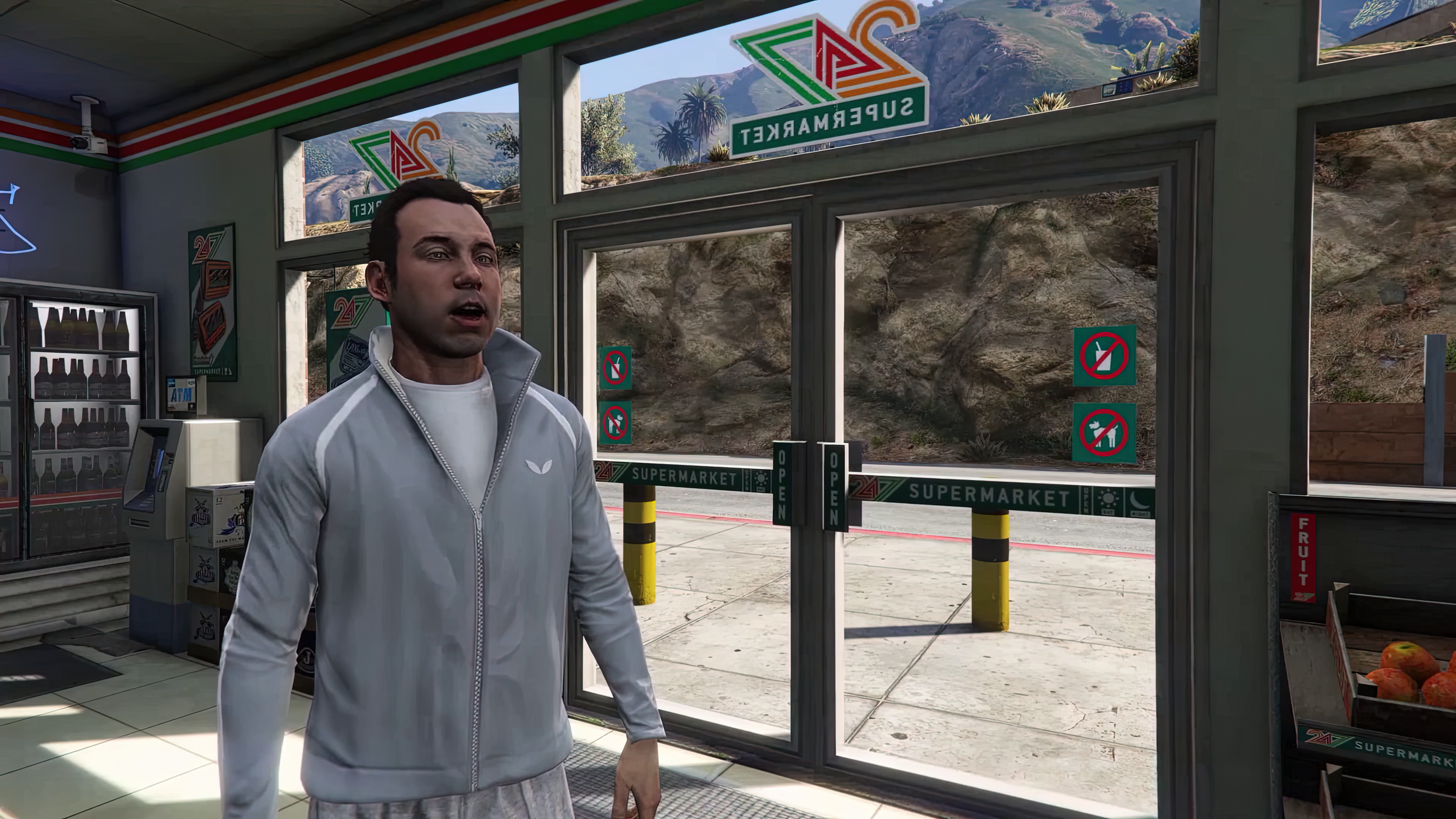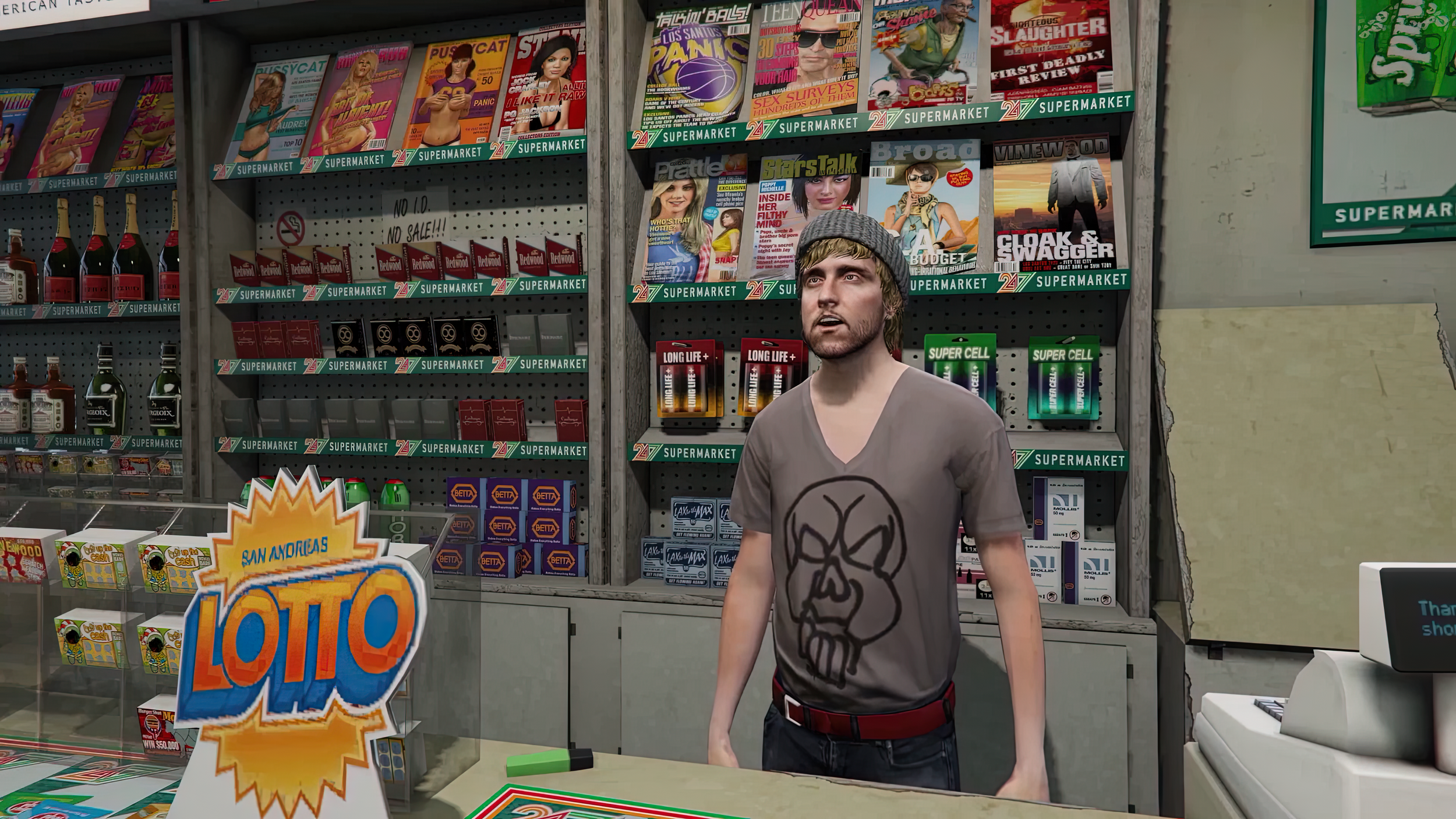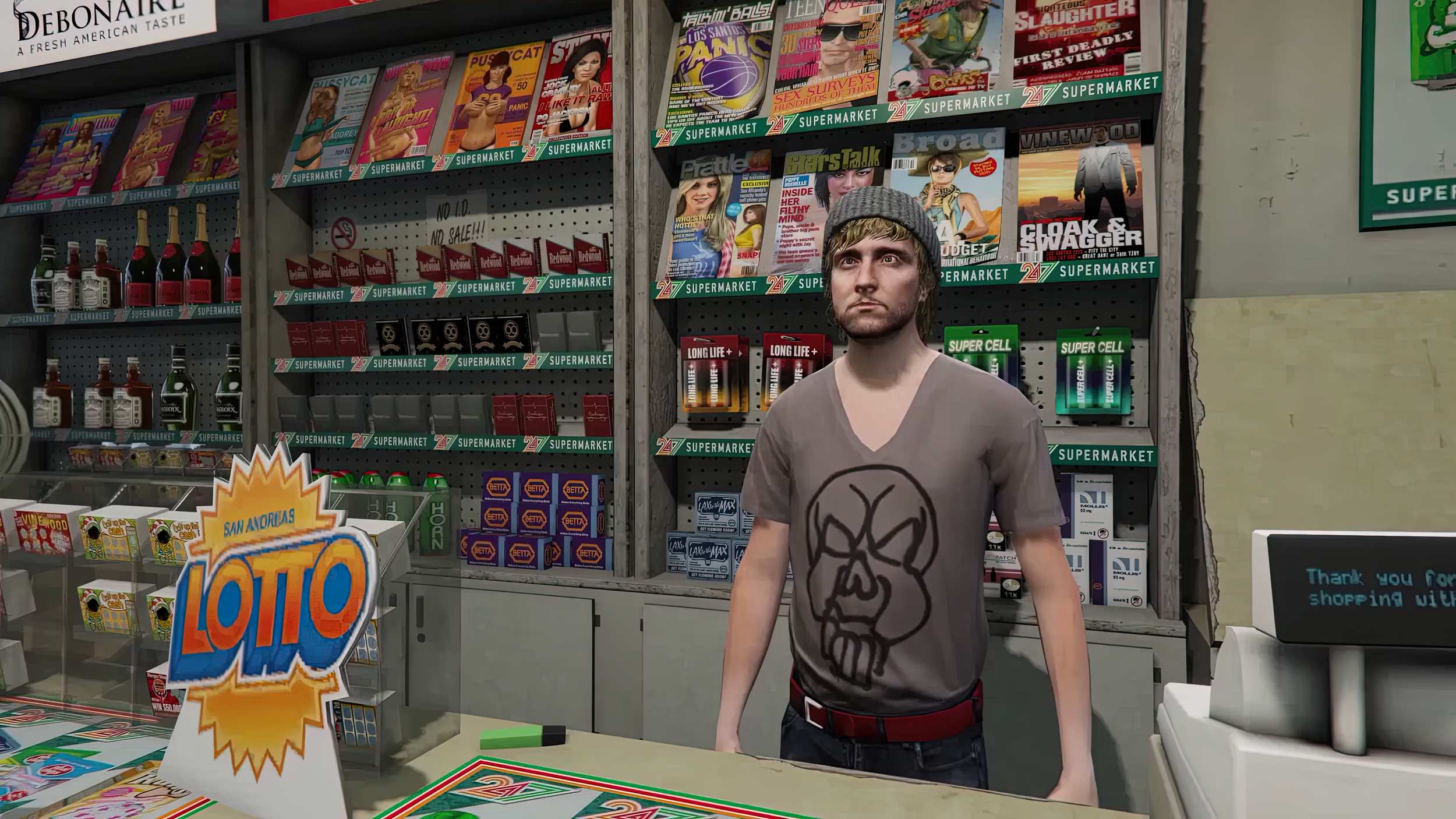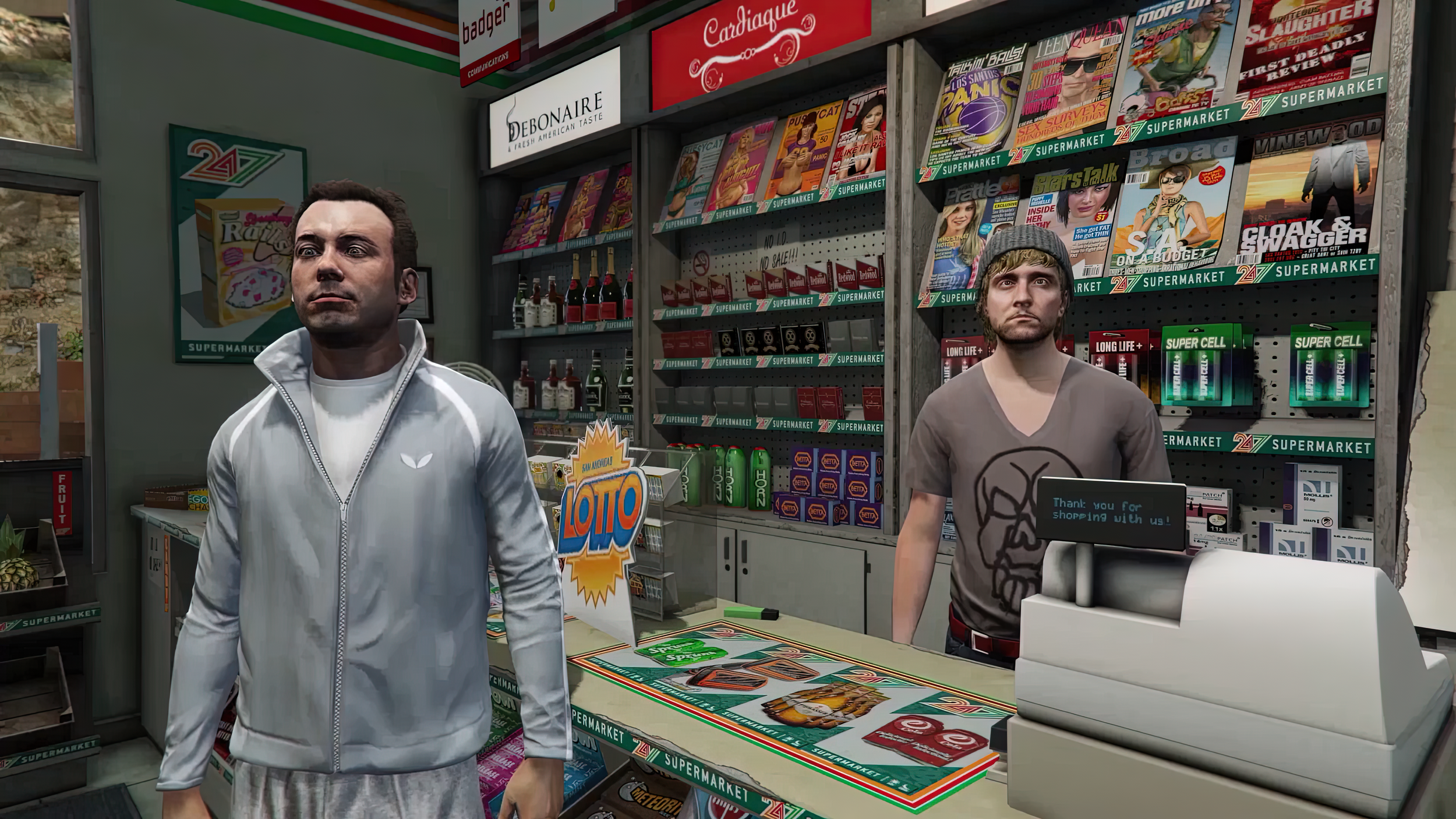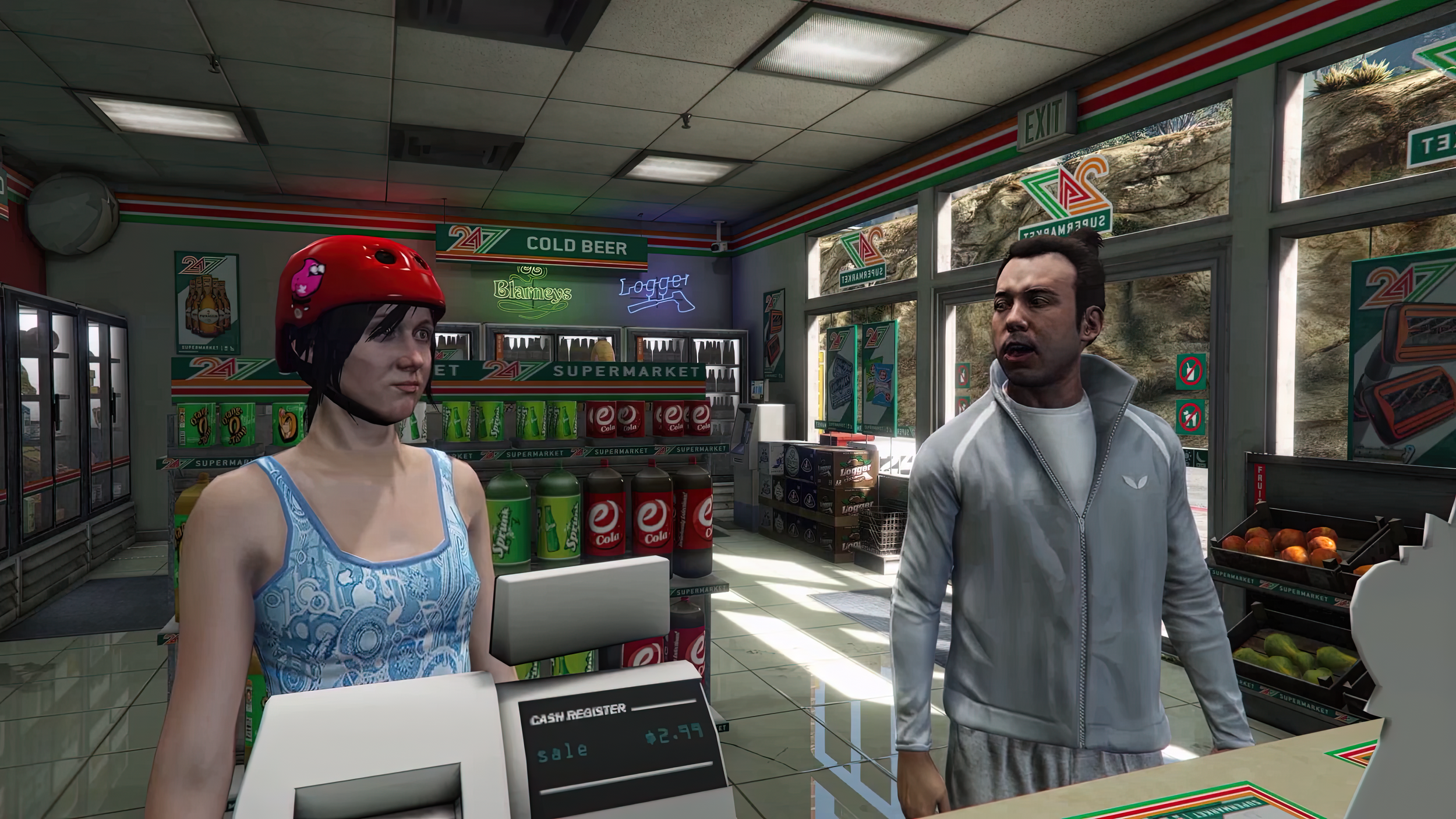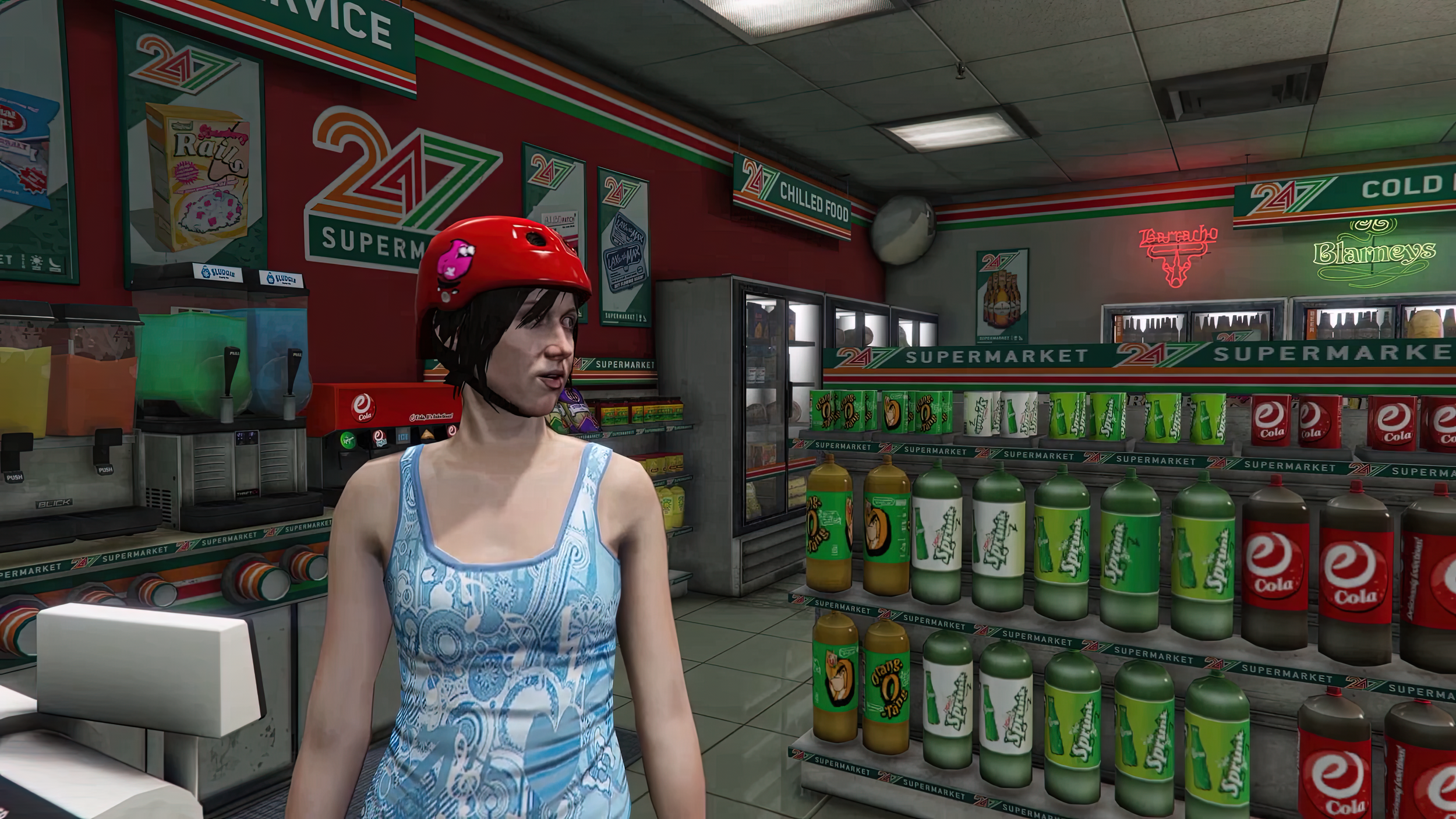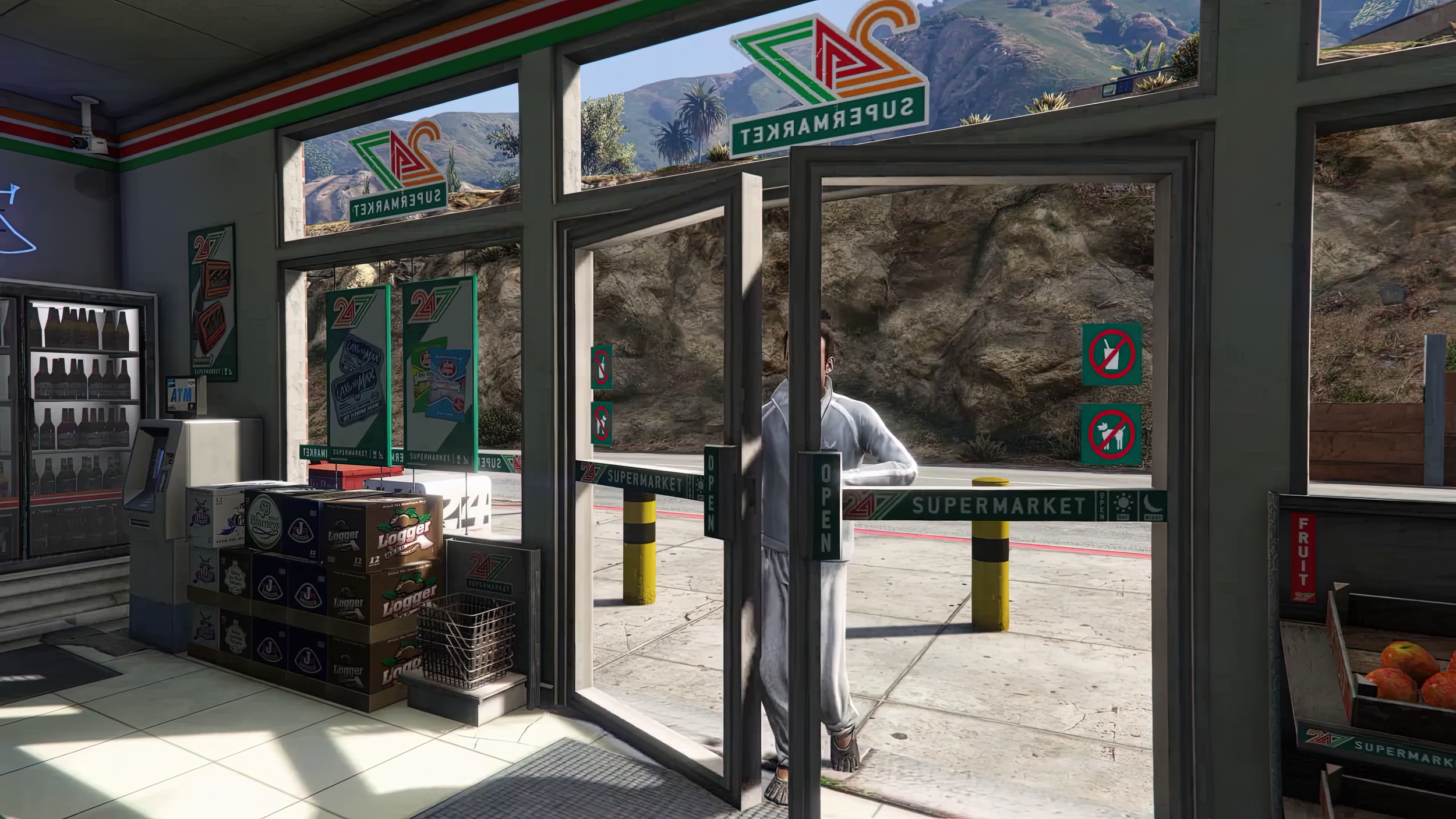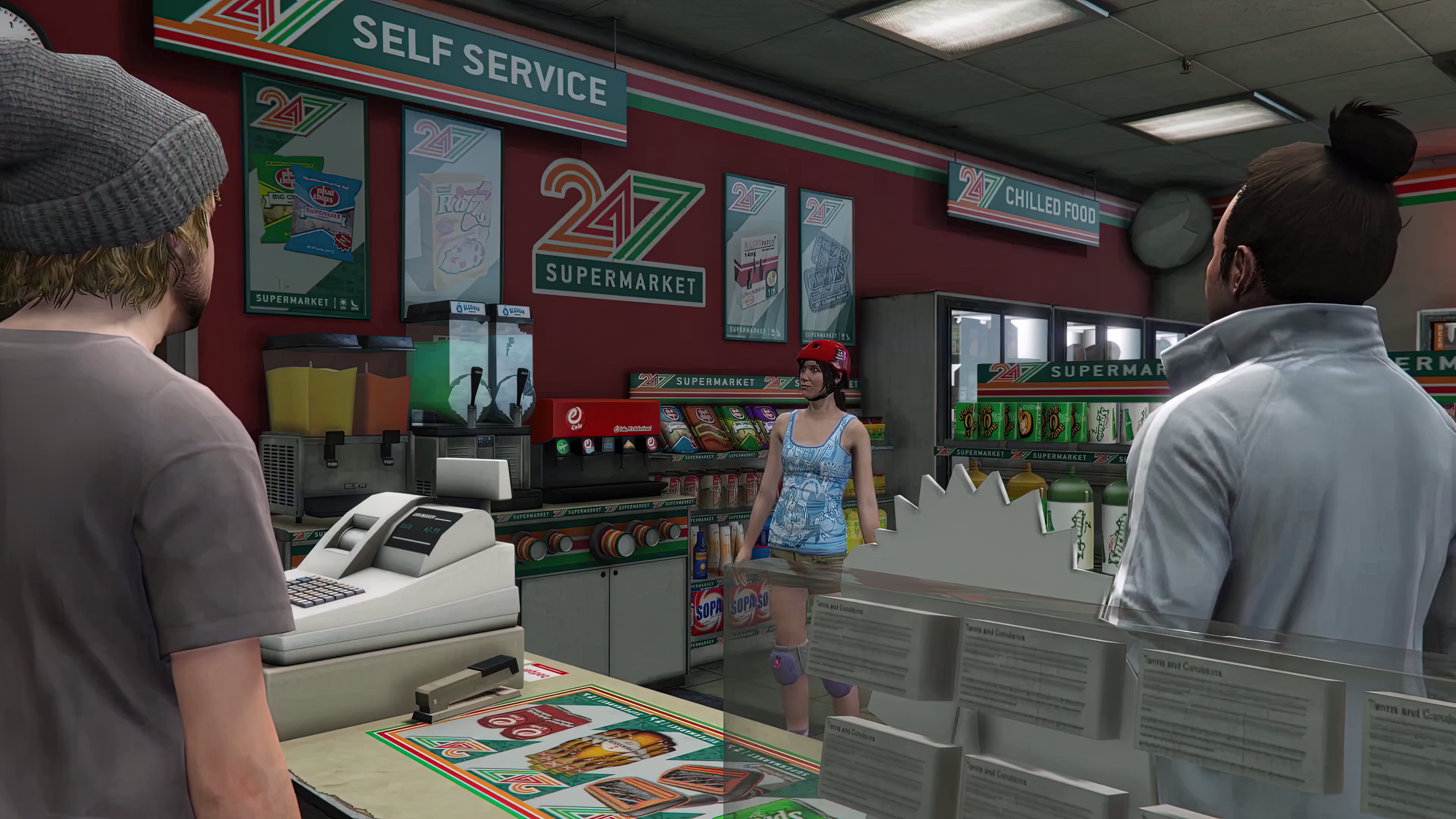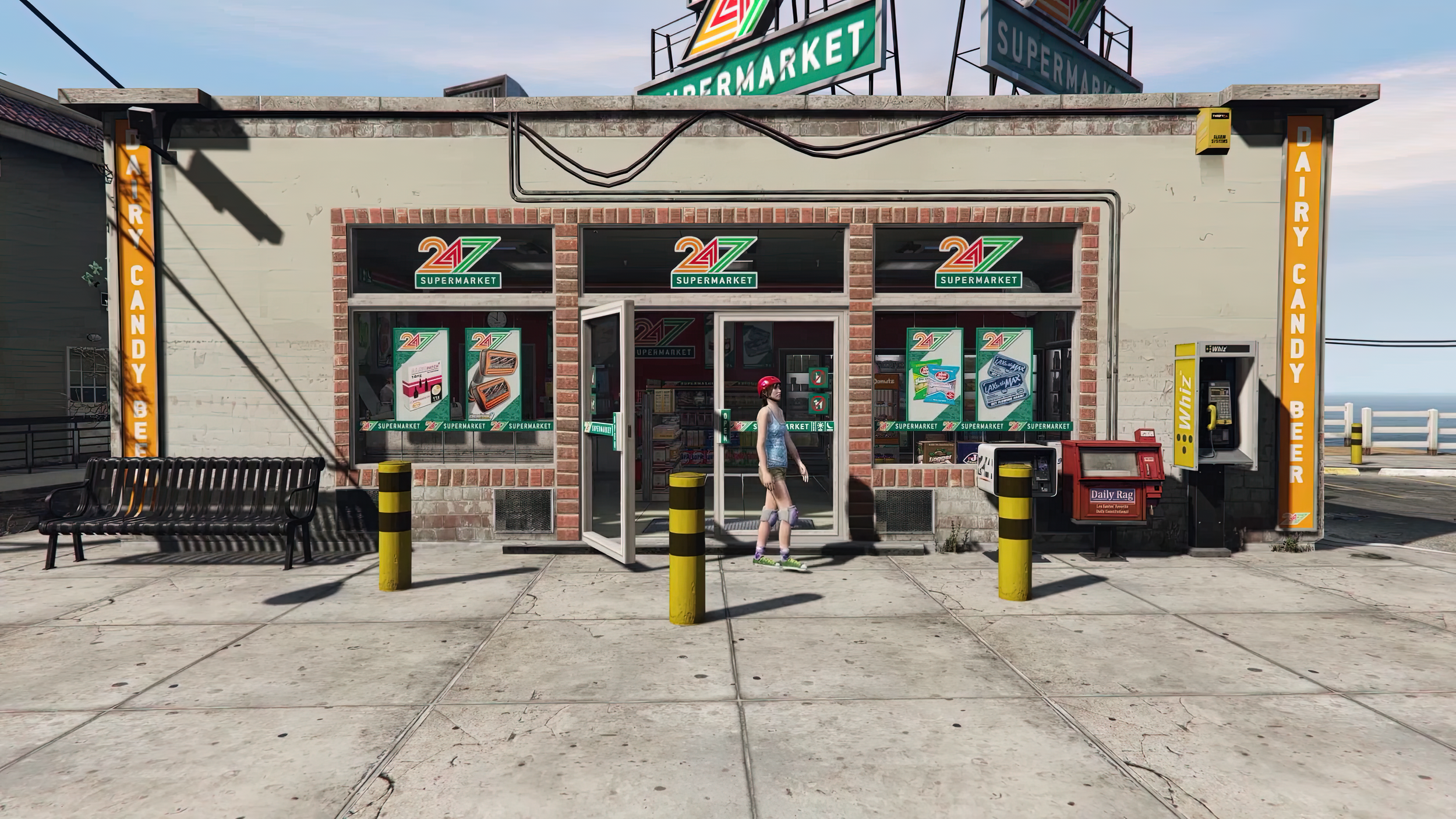THE CONVENIENCE STORE
digital video, color, sound, 6’ 23”, 2018, Sweden
Created by Jonne Hansson
The Convenience Store follows three recently former students who graduated from Umeå Academy of Fine Arts in Sweden and later moved to the fictional city Los Santos hoping to succeed as artists. They all have encountered challenges in their respective fields. One day they accidentally meet each other in a convenience store. In a setting, reminiscent of Kevin Smith’s cult film Clerks, they have a strange, meta-referential conversation.
Jonne Hansson (b. 1983) is an artist working with digital media. He received an MFA from Umeå Academy of Fine Arts, Umeå, Sweden and a BA in Fine Arts from Gerrit Rietveld Academie, Amsterdam, The Netherlands. In the past decade, Jonne has created several machinima, drawings, prints and installations. His practice is narrative driven, with an emphasis on short films or using dis- or replaced still imagery. Different interests — including video games, sports, animals, and movies — are mixed with literary classics, resulting in narrative works — ranging in tone from philosophical, to poetic, to sit-com slapstick gags — pointing out the oddness, if not absurdity, of contemporary life. His work has been exhibited internationally, including Argentina, Croatia, Italy, and Sweden. His machinima Heavy Thoughts was presented at Milan Machinima Festival MMXXII. Jonne lives and works in Sweden.
Matteo Bittanti: Can you describe the process of creating The Convenience Store? What was the context that led to the creation of such an original take on Grand Theft Auto V? What was your mental state back then?
Jonne Hansson: During my Master’s studies at Umeå Academy of Fine Arts in Umeå, I spent many hours playing Grand Theft Auto V. I wanted to be in this mock-up version of Southern California as much as possible during the long dark winters. While walking around in the city of Los Santos — which is based in Los Angeles — and watching non-playable characters walking around on the streets, I remembered a piece of text I read from How to Play a Video Game by Pippin Barr. In the chapter titled The world around us, he says:
Here’s another beautiful part of video game worlds: you don’t always have to be the centre of attention. Whether it's a neighbour doing her shopping at the local mall in The Sims or a rabbit hopping past your horse in Red Dead Redemption, many contemporary games present worlds that are at least partly complete without you: people are just getting on with their lives. At first blush that may seem somehow offensive - it's your world, after all, you bought the thing - but it's a magical experience to see a world in action, just as it is when you're a real-life traveller standing, for example, on a street corner in Paris, watching people go about their business.
After reading this text, I started to think about the lives of NPCs. Do they have their own intriguing stories? Probably not. There is a funny episode in Seinfeld called The Pitch. In this episode, Jerry Seinfeld gets asked by NBC to come up with an idea for a TV show, and George decides he can be a sitcom writer and comes up with the idea of it being “a show about nothing” with no plot, no stories. I got interested in the idea of making a short piece of machinima where the dialogue goes over the plot, like small talk. During my research about topics such as “nothing”, “the plotless”, and “the mundane”, I ran into the film Clerks (1994) by Kevin Smith. Even if there is a plot in this film, most of the film takes place in a convenience store where work colleagues, customers, and friends are, in the sense of a plotless way, talking about films, their past, relationships, etc. All these things together led me to make a machinima about an artist — with no social skills whatsoever — who works in a convenience store and accidentally gets former classmates from Umeå Academy of Fine Arts in Sweden as customers. Awkwardly they have a conversation about their struggle as artists.
Matteo Bittanti: What is machinima to you?
Jonne Hansson: Simply put, machinima is the use of video game technology as source material to produce animated films. Artists use video game technology in different ways to make cinematic animations. But, the most common and the most “pure” approach to making machinima was, originally, through live-performance acts and recorded acts within video games. Back then, the charm was how to work around the limitations of the existing technology to make new narratives. Nowadays, you can create animated films using game engines like Unity, Unreal Engine, etc. I have never tried Unity myself, but I can imagine the possibilities it might offer. In Unity, there is a feature called "Cinemachine", where you can position smart cameras like rigs, dollies and other layouts tools. Artists who have been working with the in-game video editor in Grand Theft Auto V might find in Unity a kind of transition to further explore the virtual replication of live-action cinematography. In the end, I think the idea of machinima as a starting point was to produce cinematic works more efficiently, time-wise and cost-wise. And, if you are tech-savvy you can make machinima with game engines like Unity and traditional 3D software like Blender and Maya. I don’t know much about 3D software and game engines, but I am enthusiastic about what other artists can do with it.
Matteo Bittanti: I am aware of Cinemachine, although I’ve never used it. Personally, I consider machinima a form of video art that appropriates and recontextualizes video games and video game tools, including, but not limited to game engines. Early machinima was basically an in-game performance recorded with the aid of the game’s real-time graphics engine. Since then, it has evolved and expanded considerably, so the point that the very term machinima — which is used mostly in gaming contexts, but not, for example, in contemporary art save some exceptions — has become somehow obsolete. Google Trends is far from being a reliable barometer of popularity of cultural phenomena, but the following chart is nonetheless interesting. It shows the popularity of the word “machinima” in Google Search in the United States (Chart 1) and Worldwide (Chart 2) between 2004-2022. You can see that it peaked around 2010-2011:
There are several ways of incorporating and manipulating game assets to construct some kind of audiovisual narrative. To me, machinima belongs to the broader contexts of game videos. Game video is a game-based/inspired/derived audiovisual content that lacks interactivity — otherwise it would be a video game. Examples of machinima, and thus game videos, include gameplay footage that is streamed/recorded for live/on demand consumption. It is raw or lightly edited footage from the player camera that often has the game interface superimposed. It is used mostly for documentation purposes: a record of a human or non-human performance — ranging from skill-based to free form explorations of game environments, to artistic performances in game spaces, but also tutorials and so on — Theo Triantafyllidis’s VRAL show Radicalization Pipeline is a 15-min documentation/excerpt of a live simulation which is procedurally generated by algorithms). A more complex version of machinima requires an active use of the video game environment as a set of a story or documentary. Whereas the previous example is generally unscripted, this kind of machinima is based on a script that could be more or less elaborate. Thus, it requires more planning and performance here is akin to acting in a movie or a play. Post-production — editing, dubbing, subtitles, special effects and so on — could also be significant compared to the previous example. In this case, extradiegetic elements can be added to the recorded footage. Another kind of machinima is asset compositing, which is similar to what Cassie McQuater did with Halo. An artist/filmmaker can rip assets from one or multiple games and composite them into their project. The outcome is a digital collage which often emphasizes the different nature of the juxtaposed/composited assets. There are also artists that mix live footage with machinima (consider Jacky Connolly’s Ariadne, for instance). Others use more elaborate production techniques. For example, Lena Windisch used Crazy Talk with Grand Theft Auto V to create Solastalgia, which we screened at the 2021 Milan Machinima Festival. Some artists import game assets into virtual sets/studio environments and manipulate them in all sorts of ways. Obviously, this requires a level of technical competence and mastery that transcends the basic process of recording gameplay. This is where the “animation” part of machinima (a portmanteau of machine-animation in one of its iterations) becomes more prominent. The most advanced filmmakers/artists actively modify the game with the aid of mods and experimental tools — often custom made — to create unique outcomes. Can you think of other kinds/typologies of “machinima”?
Jonne Hansson: Your examples of machinima are very interesting and well mapped out. I am far from an expert in machinima, but I hope I can expand the typology of machinima a little bit further. Thanks for showing me Theo Triantafyllidis’ live simulation Radicalization Pipeline. I am familiar with Triantafyllidis’ earlier works, especially Anti-Gone, a mixed reality performance that combines theater with digital content. In the future think it also can be interesting to mix improvisation theater with motion capture and (real-time) game engines. Maybe, this has already been achieved by Triantafyllidis himself. Another artist who works with so-called infinite self-played video games that I like is Ian Cheng. In his live simulation Emissaries Trilogy (2015-2017), the algorithm/main story is either co-operated or conflicted by agents such as humans, Shiba dogs, substance-like intelligence and other creatures living in a Hayao Miyazaki-like 3D world.
Other categories related to machinima are the meta-aspect (self-awareness) and — as you mentioned before — the use of video games as an artistic choice to make video art. An artist who does both is Benjamin Nuel. In his video work Hotel: characters from war games like terrorists, guerrilla warriors and policemen, find themselves trapped in a luxurious countryside hotel maintained by a chicken. Bored as if they miss the battlefield, they face their uselessness, doing random idle things and having existential conversations to fill their time. In an interview with Ben Vickers (Vdrome) Benjamin says:
HOTEL is not a machinima. It’s 3D animation, made with classic 3D software that imitates video games. I wanted to make believe it was a machinima, that I was filming a situation being played, as in a classic first-person shooter. But, it was also important to elaborate human-like attitudes with realism. It’s the meeting of two kinds of styles that creates the strange feeling of HOTEL.
All these mentioned artists make me see how artists can make animated films playfully through game engines and video game aesthetics. Any thoughts about these things?
Matteo Bittanti: That’s very interesting. There’s a branch of machinima studies that argues that the medium’s roots can be found in puppetry rather than cinema. Consider, for instance, Michael Nitsche’s position, along with Ali Mazalek and Paul Clifton. The hybrid, mixed, performative machinima is definitely here to stay, and in the last few years, we’ve seen more artist experimentation. I’m thinking of Kara Güt’s Welcome to my Desert Nexus or Amir Yatziv’s Kingdom of Shadows for instance. And then we should talk about the very idea of performing within a video game setting, which is the key concern of British artist Sam Crane aka Rustic Mascara. But puppetry is inherent to video game playing as a whole: think about the relationship between the player and the avatar. A decade ago, foci and loci used the original Red Red Redemption and Shadow of the Colossus for a fascinating project titled Bal(l)ade (2011-2013). The artists perform IRL while “playing” the games in ways that are not prescribed/intended by the designers. The performance is then documented through machinima. In a sense, we keep updating our cultural forms through technology...
Jonne Hansson: I have been thinking about the meaning of the word “puppetry”, relation to video games and machinima. I can understand that puppetry is inherent in video game playing — the game designer is directing the player how to pull the strings of the puppet/avatar. But, what about puppetry and making machinima? For me, machinima has a connection to disobedience and the refusal of participating in goal-oriented game design. It seems very common for artists outside of the game industry to use video games as source material to make films to highlight the particularly frustrating issue of linear game design. Artists and explorers like Total Refusal, Carson Lynn, and the Red Dead Online collective The Grannies, to name a few, are all disobeying the intended pushy game design like checkpoints, achievements, and goals that the player constantly has to respond to make progress in a video game. It is interesting when artists instead can go off-script, off-grids and explore puppeteering beyond the initial limits.
Matteo Bittanti: I completely agree with you. To me, machinima is an example of what Alexander Galloway calls counter-gaming. Artistic machinima has a subversive, contrarian, irreverent spirit, whereas most of the vernacular machinima production is purely promotional, which explains why the vast majority of video game companies not only tolerate machinima (a blatant example of copyright infringement), but incentivized “content creators” in a variety of ways — including giving them the tools to make machinima, as in the case of GTA V’s Rockstar Editor. The rare cases in which a company has explicitly objected to machinima is when somebody used a recording of a video game to make a point about gamer culture or society at large. I discussed one such instance — which involved Rockstar Games — in the 2011 book The Machinima Reader edited by Henry Lowood and Michael Nitsche. When Peter Krapp says that “gamers play video games while artists play with games”, I think of machinimakers as belonging to the latter category. Interestingly, a significant number of artists do not even use the term machinima, because of its roots in the vernacular. They wish to distance themselves from the gamer subculture while still using their language and aesthetics. They play a game of cultural demarcation..
Jonne Hansson: Yes, it seems many artists wish to distance themselves from the gamer subculture while still using their language and aesthetics. I like to take the opportunity to list a few YouTubers and content creators in the gamer culture that I have been following for inspiration, entertainment and education. I have learned a lot about retro games and discovered unusual games from watching the very dramatized video game reviews by Angry Video Game Nerd. If I wanted goosebumps, I watched playthroughs of horror games by the former YouTuber group Super Best Friends Play. It felt inviting. It was like someone was telling me, “grab a beer or a cup of hot chocolate, sit back next to the fireplace, put your feet up. I am going to tell you a scary story”. Very entertaining. When it comes to education, YouTuber Shesez’s Boundary Break series has shown how environments were built by taking in-game cameras out of bounds in different video games. Finally, without watching tutorials about making machinima in Grand Theft Auto V by the German YouTuber whanowa, it would have been hard for me to make more advanced video works within GTA V. I want to thank all these guys.
The Convenience Store
digital video, color, sound, 6’ 23”, 2018, Sweden
Created by Jonne Hansson, 2018
Courtesy of Jonne Hansson, 2022
Made with Grand Theft Auto V (Rockstar Games, 2013)




